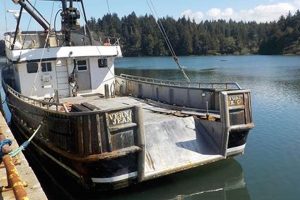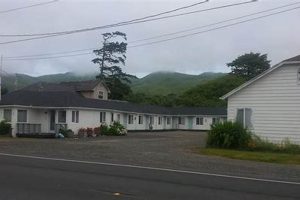The distance separating Oregon’s largest city from the Pacific Ocean is a common inquiry for travelers and residents alike. This separation influences climate, recreation, and accessibility to coastal resources. The actual distance varies depending on the specific coastal destination and the route taken.
Proximity to the ocean provides Portland with a moderate climate, while also allowing for relatively easy access to beaches, seafood, and coastal scenery. Historically, this accessibility has contributed to tourism and trade, fostering economic connections between the inland metropolis and coastal communities. The journey represents a manageable day trip for many, offering a diverse range of experiences within a short travel time.
Considering the diverse routes available and popular coastal destinations, it’s useful to examine the driving distances to several prominent locations on the Oregon Coast. Furthermore, alternative modes of transportation and the factors influencing travel time warrant further consideration.
Tips for Planning a Trip from Portland, Oregon, to the Coast
Planning a trip from Portland to the Oregon Coast requires consideration of several factors to ensure a smooth and enjoyable experience.
Tip 1: Select a Coastal Destination: The Oregon Coast stretches for over 360 miles, offering diverse attractions. Research various towns and landmarks to align with personal interests. Cannon Beach, Seaside, and Newport are popular choices, each offering unique experiences.
Tip 2: Account for Travel Time: Driving times can vary depending on the chosen route and traffic conditions. Weekends and holidays often experience increased congestion, particularly on Highway 26. Consult real-time traffic data and plan accordingly.
Tip 3: Consider Alternative Routes: Highway 26 is the most direct route to the northern coast, but Highway 18 to Lincoln City offers a viable alternative. Explore scenic backroads for a less congested, albeit longer, journey.
Tip 4: Prepare for Variable Weather: Coastal weather in Oregon is unpredictable. Pack layers of clothing, including waterproof outerwear, regardless of the season. Check the forecast before departure and be prepared for potential rain, wind, and fog.
Tip 5: Book Accommodations in Advance: Coastal lodging, especially during peak season, fills up quickly. Secure reservations for hotels, vacation rentals, or campsites well in advance to avoid disappointment.
Tip 6: Explore Activities Beyond the Beach: While beaches are a primary draw, the Oregon Coast offers numerous other activities. Consider hiking, whale watching, visiting lighthouses, or exploring tide pools to enrich the experience.
Tip 7: Be Mindful of Coastal Hazards: Exercise caution when exploring beaches and cliffs. Be aware of sneaker waves, rip currents, and unstable terrain. Heed posted warnings and advisories to ensure safety.
Careful planning, taking into account travel time, weather conditions, and activity interests, is essential for a successful trip. By implementing these suggestions, a trip from Portland to the Oregon coast can become a memorable experience.
Having addressed critical planning considerations, the following sections will discuss transportation options and related considerations.
1. Driving Distance
Driving distance serves as a fundamental metric in evaluating the spatial relationship between Portland, Oregon, and the Pacific coastline. It directly influences travel time, accessibility, and the practical feasibility of trips to coastal destinations. The actual separation is variable, contingent upon the specific coastal location chosen and the route employed.
- Variability by Destination
The mileage from Portland is not uniform across the Oregon Coast. Cannon Beach, being one of the closest destinations, presents a shorter driving distance than, for example, Newport or Florence. Consequently, the perceived accessibility of the coast is significantly influenced by the selection of a specific coastal town or region.
- Route Selection and Mileage
Multiple routes connect Portland to the coastline, each with associated mileage. Highway 26 represents a more direct path to the northern coast, while Highway 18 provides access to the central coastal region. Alternative routes, though potentially scenic, may add to the overall driving distance and travel time.
- Impact of Road Conditions
Driving distance as a numerical value does not fully capture the experience of travel. Road conditions, including weather-related hazards or construction zones, can significantly impact the effective driving distance. Congestion during peak seasons or weekends extends travel time, effectively increasing the perceived distance.
- Psychological Distance
The numerical driving distance correlates with a psychological perception of proximity. A shorter driving distance to a favorite coastal location can foster more frequent visits, while a longer distance may deter spontaneous travel. This psychological factor influences tourism patterns and the economic relationship between Portland and coastal communities.
The driving distance from Portland to the Oregon Coast is, therefore, a multifaceted consideration. It encompasses not only the physical mileage but also factors of route, road conditions, and individual perception. Understanding these elements provides a comprehensive perspective on accessibility and the practical implications of the spatial relationship. Determining how far is portland oregon from the coast necessitates an evaluation beyond simple mileage, incorporating an understanding of the variables at play.
2. Coastal Destination
The selection of a coastal destination directly influences the perceived and actual distance separating it from Portland, Oregon. This choice functions as the primary variable in determining the answer to the query of spatial separation. Not all points along the Oregon coastline are equidistant from Portland; therefore, specifying a destination is paramount. For example, a trip to Cannon Beach, located on the northern coast, will necessitate a shorter journey than a trip to Brookings, situated near the California border. This distinction underscores the destination as the causal factor in establishing the relevant mileage.
The importance of the coastal destination extends beyond merely determining distance. Each town and region along the Oregon Coast possesses unique characteristics that influence traveler choices. These include differences in scenery, available activities, lodging options, and local culture. Seaside, with its arcades and bustling promenade, provides a different experience from the quiet, rugged beauty of Yachats. Therefore, individuals seeking to understand the separation consider not only the mileage but also the specific attributes of the intended destination.
In summary, the answer to the question depends entirely upon the coastal destination in question. Variations in the journey’s length are a direct consequence of the selected town or region, making it a critical component in the calculation. Ignoring the destination renders the inquiry vague and unanswerable. Furthermore, destination choice depends on several attributes making it the most impactful on Portland-Oregon distance.
3. Route Options
The selection of route options significantly influences the total distance traveled between Portland, Oregon, and various points along the coast. The geographical separation is not fixed; it is contingent upon the chosen path. This interdependency between available routes and overall mileage is a critical element in estimating travel requirements.
- Highway 26: The Most Direct Path
Highway 26, also known as the Sunset Highway, provides the most direct route to the northern Oregon coast, particularly popular destinations like Cannon Beach and Seaside. While offering the shortest driving distance under optimal conditions, this route is subject to congestion, especially during peak tourist seasons and weekends. The presence of delays can negate the advantage of the shorter distance, increasing overall travel time.
- Highway 18: An Alternative to the Central Coast
Highway 18 offers an alternative route to the central Oregon coast, leading to towns such as Lincoln City. While potentially involving a slightly greater distance compared to routes further north, Highway 18 can provide a less congested option, particularly during periods of high traffic volume on Highway 26. The trade-off between distance and traffic flow is a crucial factor in route selection.
- Coastal Highway 101: A Scenic but Indirect Choice
Once reaching the coast, Highway 101 (the Oregon Coast Highway) runs north-south along the entire coastline. While offering unparalleled scenic views, relying solely on Highway 101 from Portland is impractical due to its indirect path. Typically, travelers use a primary east-west route to reach the coast and then utilize Highway 101 for exploring different coastal towns. This option adds to the total mileage from Portland to a specific destination further along the coast.
- Backroads and Forest Service Roads: Extended Travel
Various backroads and Forest Service roads offer alternative, often more scenic, routes to certain coastal areas. These routes typically involve significantly longer distances and travel times due to lower speed limits, winding roads, and potential for unpaved surfaces. While attractive for those seeking solitude or a unique experience, these options are generally not recommended for travelers prioritizing efficiency or directness.
The route selection is not merely a matter of picking the shortest path on a map. It requires careful consideration of potential traffic delays, road conditions, and individual preferences for scenic drives versus direct travel. Understanding these factors is essential in accurately assessing the distance and time required to reach the Oregon coast from Portland.
4. Travel Time
The phrase ‘how far is portland oregon from the coast’ is intrinsically linked to travel time. While distance quantifies physical separation, travel time reflects the duration required to traverse that distance. This temporal component is a crucial consideration for individuals planning trips between the city and the coastline. The mileage, even when known precisely, lacks practical value without an accompanying estimate of the hours required for the journey. For example, a 90-mile trip that typically requires 1.5 hours under ideal conditions can easily extend to 3 or more hours due to traffic congestion. Thus, travel time effectively modulates the perceived separation between Portland and the ocean.
Numerous factors influence the connection between distance and duration. These include road conditions, traffic density, seasonal weather patterns, and the specific route chosen. Highway 26, while often the shortest route to the northern coast, is prone to congestion, particularly during peak seasons and weekends, substantially increasing travel time. Alternative routes, though potentially longer in mileage, may offer faster transit due to reduced traffic. Moreover, unforeseen events such as accidents or road construction can significantly disrupt travel schedules, further emphasizing the inherent variability in this relationship. Mapping applications often provide estimated travel times, but these are subject to real-time fluctuations.
Ultimately, while distance serves as a baseline measure, travel time is a more practical indicator of accessibility. For individuals contemplating day trips or weekend getaways, the estimated duration of the journey often outweighs the precise mileage. Accurate assessment of travel time, therefore, requires consideration of multiple dynamic variables, reflecting the complex interplay between physical separation and temporal experience. Recognizing this relationship enhances decision-making and planning related to trips to the coast from Portland.
5. Traffic Conditions
Traffic conditions are a crucial determinant of the perceived and actual distance from Portland, Oregon, to the coast. While geographical mileage remains constant, the time required to traverse that distance fluctuates considerably based on the prevailing traffic patterns. Congestion effectively expands the separation between the city and coastal destinations, impacting travel plans and accessibility.
- Peak Season Congestion
During summer months, holidays, and weekends, traffic volume significantly increases on routes connecting Portland to the coast, particularly Highway 26. This influx of vehicles results in substantial delays, extending travel times to popular destinations such as Cannon Beach and Seaside. The increased congestion effectively negates the advantage of these destinations’ relative proximity, transforming a typically short drive into a considerably longer ordeal.
- Commuter Patterns and Weekday Traffic
Weekday traffic patterns also influence travel times, though often to a lesser extent than peak season congestion. Commuters traveling between Portland and coastal communities for work contribute to increased traffic volume during morning and evening rush hours. Construction projects and road maintenance can further exacerbate these conditions, leading to unexpected delays. Careful planning and consideration of these weekday patterns are essential for efficient travel.
- Impact of Accidents and Road Closures
Unforeseen events such as accidents or road closures can dramatically impact traffic conditions and travel times. Even minor incidents can create significant backups, particularly on narrow or winding stretches of highway. Real-time traffic updates and alternative route options become invaluable in mitigating the effects of these unpredictable events.
- Weather-Related Delays
Adverse weather conditions, including heavy rain, snow, or fog, frequently affect traffic flow on coastal routes. Reduced visibility and slippery road surfaces necessitate slower speeds, increasing travel times and the risk of accidents. Winter storms can lead to temporary road closures, effectively isolating coastal communities and preventing travel from Portland. Monitoring weather forecasts and exercising caution are crucial during inclement weather.
In conclusion, traffic conditions serve as a dynamic modifier of the spatial relationship between Portland and the Oregon coast. The geographical distance is fixed, but the experience of that distance is significantly altered by the ebb and flow of vehicular traffic. Understanding these patterns and adapting travel plans accordingly are essential for efficient and predictable journeys.
6. Geographic Impact
The spatial separation between Portland, Oregon, and the Pacific coastline exerts a tangible geographic impact on both the city and the coastal regions. This separation, which is essentially an expression of the land’s physical attributes, directly influences climate patterns, economic activities, and transportation infrastructure. The degree of this influence varies depending on the specific coastal area and the route taken, but the presence of this effect is undeniable. For instance, Portland benefits from a moderated climate due to its relative proximity to the ocean, experiencing milder temperatures and increased precipitation compared to inland areas further removed from maritime influence. This climatic moderation, in turn, affects agricultural practices and residential energy consumption within the Portland metropolitan area.
The ocean proximity also facilitates economic exchange, with Portland serving as a major transportation hub for goods moving to and from coastal communities. The ease of access impacts real estate values, tourism patterns, and the demand for recreational activities. Coastal towns depend on Portland for distribution of goods and access to larger markets, with that dependency modulated by separation. Seafood processing and distribution, for instance, rely on efficient transportation networks to connect coastal fisheries with Portland’s markets and broader distribution channels. Conversely, longer distances to specific coastal locations may hinder economic activity, increasing transportation costs and reducing market access for those areas.
The geographical relationship challenges resource planning and infrastructure development. Transportation corridors must be maintained to accommodate both passenger and freight traffic, particularly during peak seasons when coastal destinations experience surges in tourism. Moreover, the potential for natural disasters, such as earthquakes and tsunamis, necessitates careful planning and investment in resilient infrastructure along both the coastal zone and the connecting inland areas. The understanding of geographic separation, therefore, is not simply an academic exercise but a practical imperative for sustainable development and risk management in the region.
Frequently Asked Questions
This section addresses common inquiries regarding the separation between Portland, Oregon, and the Pacific coastline, providing clarity and practical information.
Question 1: What is the average driving distance from Portland to the Oregon Coast?
The driving distance varies depending on the specific coastal destination. However, a general range is between 75 and 90 miles to reach the northern Oregon Coast (e.g., Cannon Beach, Seaside) from Portland. Central and southern coastal areas involve longer drives.
Question 2: What is the quickest route to the Oregon Coast from Portland?
Highway 26 (the Sunset Highway) is typically the quickest route to the northern Oregon Coast. However, travel time is subject to traffic conditions, particularly during peak seasons and weekends.
Question 3: How long does it generally take to drive from Portland to the Coast?
Assuming minimal traffic, the drive to the northern Oregon Coast typically takes between 1.5 and 2 hours. Journeys to central or southern coastal locations require correspondingly longer travel times.
Question 4: Is it possible to take public transportation from Portland to the Coast?
Limited public transportation options exist. While it is possible to reach some coastal towns via a combination of buses, it is generally not recommended due to the lengthy travel times and infrequent service.
Question 5: How do traffic conditions affect travel time to the Coast?
Traffic congestion significantly increases travel time, particularly during peak seasons, holidays, and weekends. Delays can add hours to the journey, especially on Highway 26. Checking real-time traffic data is recommended.
Question 6: Are there alternative routes to the Coast besides Highway 26?
Yes, Highway 18 offers an alternative route to the central Oregon Coast. Other less-traveled routes exist, but these typically involve longer distances and potentially challenging road conditions.
The proximity of Portland to the Oregon Coast allows for convenient day trips and weekend getaways. Understanding the influencing factors enhances trip planning.
This understanding provides a solid foundation for subsequent explorations of coastal experiences.
Conclusion
The preceding discussion has meticulously dissected the inquiry “how far is portland oregon from the coast.” The analysis has demonstrated that a definitive answer necessitates consideration of multiple variables, including the intended coastal destination, the chosen route, and prevailing traffic conditions. Physical distance, while a fundamental element, is ultimately modulated by temporal factors, making travel time a crucial consideration. The geographical relationship between Portland and the coastline further influences climate, economy, and infrastructure planning, underscoring the multifaceted nature of this spatial connection.
Understanding the complexities surrounding the distance between Portland and the Oregon Coast empowers informed decision-making for travelers and residents alike. Further research into specific coastal destinations and real-time traffic patterns will refine trip planning and enhance the overall experience. The continuing development of transportation infrastructure and resource management strategies will ensure sustained accessibility and mitigate the challenges posed by this dynamic geographical relationship.







